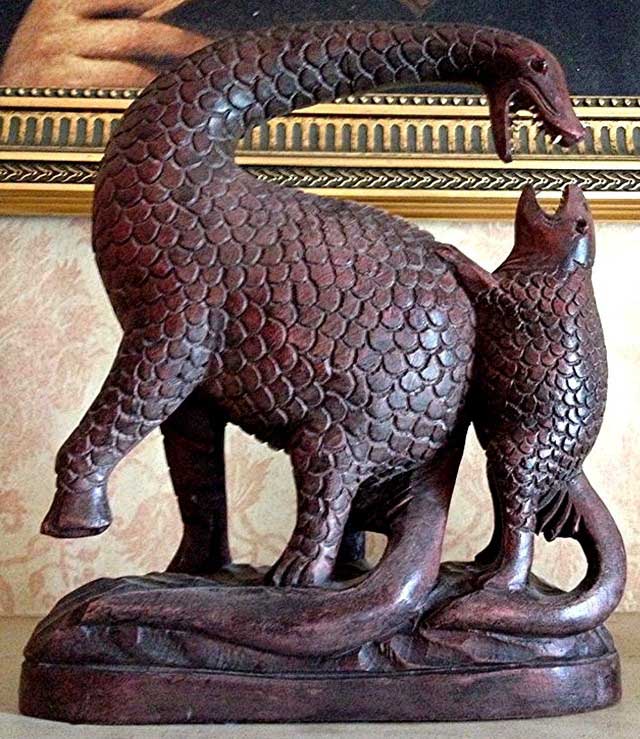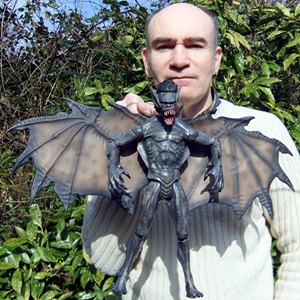A Scaly Statuette of the Mokele-Mbembe?
Posted by: Karl Shuker on December 23rd, 2016
On 7 April 2013, Brother Richard Hendrick, a Capuchin Franciscan Friar (Monk) of the Irish Province who has long been interested in cryptozoology, posted on my ‘Journal of Cryptozoology’ Facebook group’s page a colour photograph that he had snapped a few days earlier, depicting a very eyecatching wooden statuette, and which I have included here by kind permission of Brother Richard. He also included the following details about it: “Found this African carving in a collection held by the Rosminian Missionary Fathers in Glencomeragh House, Clonmel [in County Tipperary] Ireland. No provenance or date other than sometime this century [sic – he meant the 1900s] probably from west Africa. Intriguing?” It is indeed, as it portrays a scaly long-necked, sturdy quadrupedally-bodied, long-tailed creature bearing more than a passing resemblance to eyewitness descriptions of the sauropod dinosaur-like cryptid known as the mokele-mbembe in the Congo and by other names elsewhere in tropical Africa. Yet until I documented it in my newly-published mega-book Still In Search Of Prehistoric Survivors, it had never been formally included within the cryptozoological literature.

(c) Brother Richard Hendrick
Equally intriguing, however, is the nature and possible identity of the smaller scaly beast alongside it. Could this be its young, or is it something totally different that is confronting the long-necked mystery beast?
Further details can be accessed here on my ShukerNature blog, and also in Still In Search Of Prehistoric Survivors.
About Karl Shuker
My name is Dr Karl P.N. Shuker. I am a zoologist (BSc & PhD), media consultant, and the author of 25 books and hundreds of articles, specialising in cryptozoology and animal mythology. I have a BSc (Honours) degree in pure zoology from the University of Leeds (U.K.), and a PhD in zoology and comparative physiology from the University of Birmingham (U.K.).
I have acted jointly as consultant and major contributor to three multi-author volumes on cryptozoology and other mysterious phenomena.
I am the Life Sciences Consultant to The Guinness Book of Records/Guinness World Records (Guinness: London, 1997-present day), and was consultant to Monsters (Lorenz Books: London, 2001), as well as a contributor to Mysteries of the Deep (Llewellyn: St Paul, 1998), Guinness Amazing Future (Guinness: London, 1999), The Earth (Channel 4 Books: London, 2000), and Chambers Dictionary of the Unexplained (Chambers: London, 2007).
I appear regularly on television & radio, was a consultant for the Discovery TV series Into the Unknown, and a question setter for the BBC's quiz show Mastermind.
I am a Scientific Fellow of the Zoological Society of London, a Fellow of the Royal Entomological Society, a Member of the Society of Authors, and the Cryptozoology Consultant for the Centre for Fortean Zoology (CFZ).
I have written articles for numerous publications, including Fortean Times, The X Factor, Paranormal Magazine, FATE, Strange Magazine, Prediction, Beyond, Uri Geller's Encounters, Phenomena, Alien Encounters, Wild About Animals, All About Cats, All About Dogs, Cat World, etc.
In 2005, I was honoured by the naming of a new species of loriciferan invertebrate after me - Pliciloricus shukeri.










really cool!!
always wondered about this thing.
i mean the locals there KNOW what they are seeing… they see the same animals for generations…
could something like that be real?
its obviously in the middle of nowhere so not much is known out there…
anyone have more info on this story?
🙂
The smaller creature on the right is even more interesting. And of course the pose is very interesting indeed.
On first look, it does not appear to be African in origin. In material, composition and execution it looks more European, perhaps Asian. African sculpture is generally more stylistic and less objective. Typical animal carvings look nothing like the piece at hand, probably owing to their spiritual and religious purposes.
One of the difficulties in establishing provenance in our cosmopolitan world is that it has been cosmopolitan for centuries. Just as an Irish monastery could possess a work of African art, which I do not believe this is, West Africans in the early 1900s could possess works of European and even Asian origin.
Interestingly, the first brontosauruses were unearthed in the late 19th Century and could be found on display in the early 20th. Which is an interesting coincidence as to the date of the statue.
That said, the authenticity of this sculpture has little to do with that of Mokele-Mbembe itself.